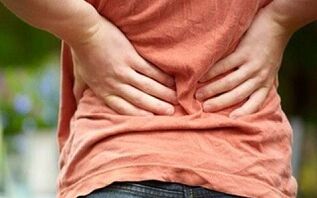
We’re sure you’ve read and heard that low back osteochondrosis often affects bank employees and office workers, programmers and representatives of heavy physical workers. This is true, but the whole truth is that today it is almost impossible to find at least one type of activity that is not related to the risk of contracting the disease.
Why is that? Osteochondrosis of the lower back is a kind of "tax for walking upright", a tribute we should pay to nature. The cause of degenerative changes in the cartilage tissue of the intervertebral disc is not so much due to the increased load on the nucleus pulposus, but on the privilege of the blood supply to this structure.
By the twentieth year of life, the arteries that feed fibrocartilaginous tissue from IVD in adolescence are eliminated, and for the remaining years, the nucleus pulposus and annulus fibrosus receive nutrients exclusively through diffusion, and this is clearly not enough! Trace elements, polysaccharides, amino acids and other structural components enter chondrocytes (cells that synthesize disc interstitial substances) in very limited quantities, which makes fertile ground for the development of dystrophic processes.
While carrying out our professional activities, we regularly throw seeds into this fertile soil. We sit in the wrong position, lift weights incorrectly, move a little and spend a lot of time behind the wheel or behind a computer monitor. All other things being equal, such a form of physical activity "will get rid of us", but in a situation of limited supply of cartilage structures in IVD, the degenerative process will inevitably develop.
How is lower back osteochondrosis manifested?
The first manifestation of lumbar osteochondrosis is pain syndrome. As a rule, for the first time a "lucky man" is attacked by a sharp pain in his back, which pierces his body with a dagger. Pain occurs after trunk contact, tilt, or after inadvertent hypothermia. There is no way to withstand such pain - literally knitting someone with his hands and feet and helping him sleep.
What changes occur in the spinal space with a background of pain syndrome? To reduce pain, the nervous system sends stimulating signals to the muscles in the back. Strengthening muscle tone helps reduce movement in the affected part of the spine, which for some time reduces the severity of pain. In the future, myofixation ceases to perform a compensatory function, and muscle tonic imbalances only increase pain.
While examining such a patient, the neuropathologist will detect signs of fixation syndrome, or objective symptoms of the disease - static and dynamic changes. By static changes in lower back osteochondrosis, we mean complementing or intensifying physiological curvature (lordosis) and the emergence of pathological curvature of pain (scoliosis). The dynamic symptom of the disease is a sharp limitation of mobility (up to complete immobilization) in the affected segment.
All of these changes can be confirmed using spondylography (X-rays of the spine) and more modern research methods such as computed tomography and MRI. The picture also shows a decrease in disc height in the area of clinically significant PDS, hernial protrusion, osteophytes.
Posterior osteochondrosis, treatment
Fixation and pain syndrome in combination with morphological signs on the diagnostic picture form a complete picture of vertebral syndrome, which is caused by osteochondrosis of the lower back. The next question we ask the doctor after completing the diagnostic stage is how to treat this disease?
Of course, it is not always the disease that needs to be cured, but the patient, but we will not miss the philosophical discussion. And we will solve a more pressing problem - first we have to tackle the pain syndrome. To do this, we need systemic and local action medications, such as NSAIDs, corticosteroid hormones, muscle relaxants, and possibly even antidepressants. After relieving the pain syndrome comes the turn of conservative treatment methods.
If you have been diagnosed with back osteochondrosis, the treatment will be long, and you should be prepared for this both morally and financially. In fact, it is impossible to overcome this disease completely, so with a certain frequency you must see a doctor until the end of your day.
Treatment algorithms are always individual in nature, and developed by physicians who know the history of the disease, we will only list the possibilities of therapy. Reflexology has a positive effect, among the methods in which acupuncture comes in the first place. Some experts advocate traction therapy, although other schools of vertebrology reject this technique. Need to try massage therapy, you definitely need to include back exercises (LFK) in your rehabilitation program, you can also get the help of a qualified chiropractor.
In 90 cases out of 100 conservative methods of therapy sufficient to control the disease, the remaining ten patients were indicated to undergo surgical treatment. If there is no absolute indication for surgery (severe spondylolisthesis, spinal stenosis), treatment with minimally invasive surgery is possible. If the degree of spinal morphological changes has reached a critical level, modern methods of disc reconstruction using implants are used.























